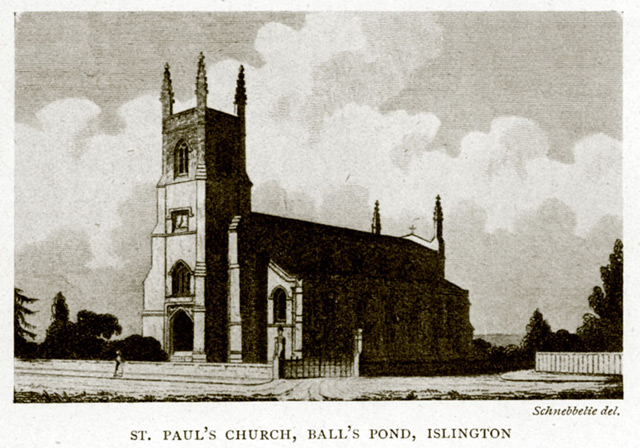

Previous page | Next page

|
| © www.lookandlearn.com |
- St Paul's was a new parish church built in 1828 as part of the Million Churches scheme and is a fine example of the early work of the architect Charles Barry.
- It was divided from Islington Parish in 1825 (the interior of the building was substantially altered in 1880).
- It was declared redundant and the parish united with St Judes Mildmay Park in 1980.
- The building was empty from 1980-84 and was badly damaged over this period.
- In 1994 a new lease was signed by the St Paul's Steiner Project. Since then the Project has worked year by year to repair and restore the building.
St Paul's is sited on land which was part of the estate of the Marquis of Northampton and had been earmarked for a church building in the early 1800's. The pasture land was used for the extraction of clay immediately prior to building houses - which were to form the Marquis Estate in 1835. It is described as 'brick fields' in 1800. The farm land around had long been divided into market garden and plant nursery uses.
The administrative Parish of Islington was very long in the north south dimension - just as the Borough is today. The subdivided north end of the Parish was to serve the growing population centred along Balls Pond Road and Newington Green.
Major local development centred on the Angel area. There was a discontinuous scatter of building along Essex Road. To the north of the site the village of Newington Green was a long established village on the road to Stoke Newington and part of that Parish.
The immediate site to the north, across Hopping Lane (St Pauls Road) was the Brooks Nursery, one of the largest plant nursery establishments in London in an area famous for these. Opposite stood a terrace with the original Schoolhouse. A small part of this terrace survives in the form of a Gothic style villa, now no 9 St Pauls Road.
Facing the church across Essex Road was Glebe Terrace parts of which survive, and a planned group of streets with terraced houses predated the 1830's-50's development around what is now Leroy House, Dorset Street and Orchard Place.
Balls Pond Road was a scattered line of artisan houses and middle class villas leading eastwards towards the Parish of Hackney.
The size of the site was determined by the Church Building Commission. The government Order in Council controlling the expenditure of the Church Building Commission stipulated that there should be no burial grounds provided with new churches and that the land around the building should extend to no more than 18 feet from the footprint of the building.
Previous page | Next page